This comparison will present a detailed overview of the Levoit Core 400S and Xiaomi Mi 3H air purifiers. These are two reliable air purifiers that come from globally top-rated brands.
Levoit is a brand that is primarily focused on producing air purifiers, while Xiaomi produces many different types of electrical products and is widely recognized. I believe that there is no person who hasn’t heard of it.
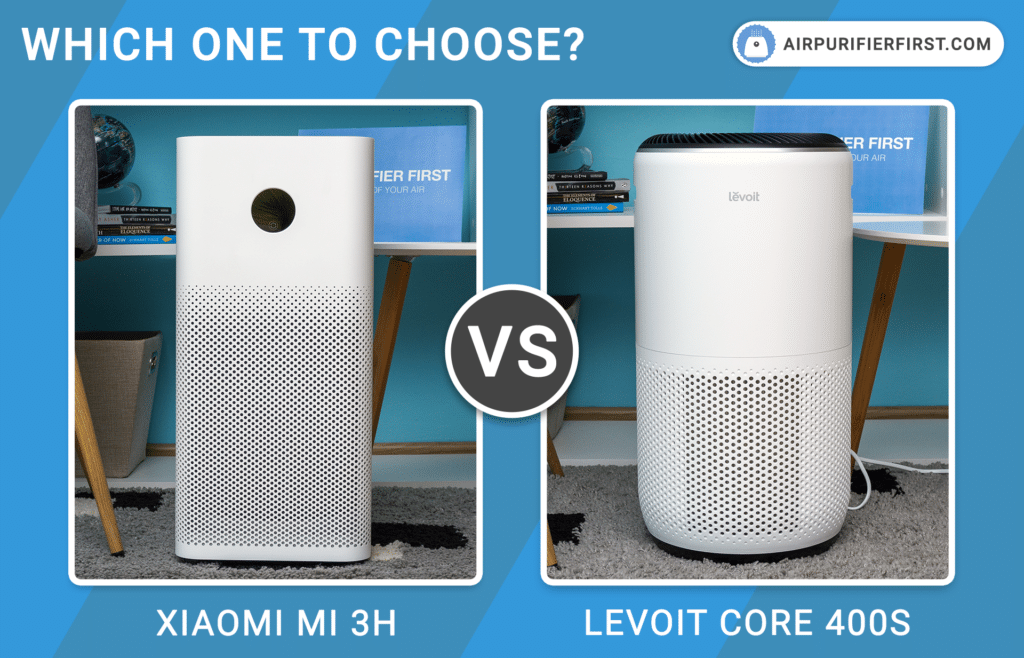
Table of Contents
What is fascinating about these two air purifiers and what makes this comparison interesting are their very similar specifications such as room coverage, smart options, and outstanding and competitive test results. All of these factors make the comparison much more valuable and helpful for future owners.
The Levoit Core 400S covers rooms up to 403 sq. ft., while the Xiaomi covers slightly larger rooms, up to 484 sq. ft. Both devices use 3-stage filtration technology, do not produce ozone, are highly reliable, and are undoubtedly a perfect buying option.
In the following comparison, I will present and analyze all the characteristics of these two air purifiers, including the results of performance tests and a comparison of noise levels. In the end, I will announce the winner.
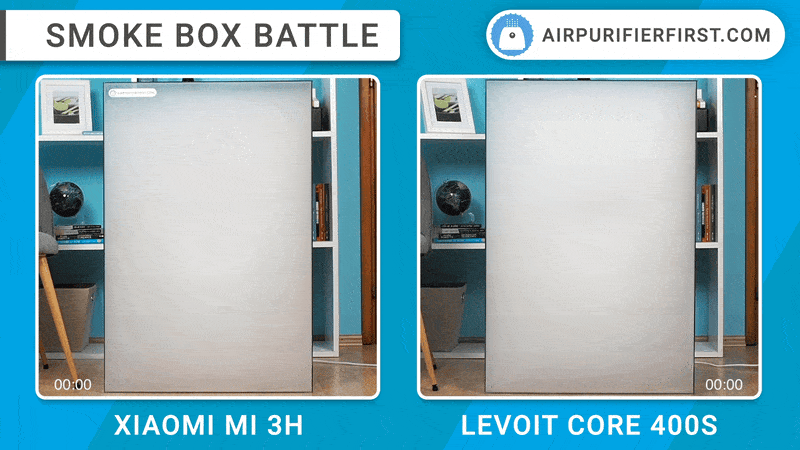
Xiaomi Vs Levoit Specifications
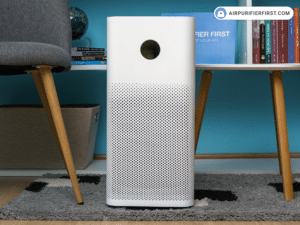 |
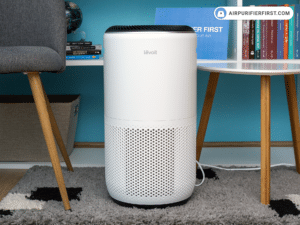 |
|
| Manufacturer | Xiaomi | Levoit |
| Model | Mi 3H | Core 400S |
| Dimensions | 9.5 x 9.5 x 20.5 inches (24 x 24 x 52 cm) | 10.8 x 10.8 x 20.5 inches (27.4 x 27.4 x 52 cm) |
| Room Coverage (4.8 ACH) | 484 sq. ft. | 403 sq. ft. |
| Performance Ratings | ||
| Filtration Technology | Pre-filter, True HEPA Filter, and Activated Carbon Filter | Pre-filter, True HEPA Filter, and Activated Carbon Filter |
| Filter Replacement Indicator | Yes | Yes |
| Filter Longevity | 6-12 months | up to 12 months |
| Power | 38W | 38W (24W European Model) |
| Operating Costs Ratings | ||
| Fan Speeds | 5 – Sleep Mode, Speed 1, Speed 2, Speed 3, and Max Speed | 5 – Sleep Mode, Low Mode, Medium Mode, High Mode, and Turbo Mode |
| Air Quality Sensor | Yes | Yes |
| Air Quality Indicator | Yes | Yes |
| Auto Mode | Yes | Yes |
| Sleep Mode | Yes | Yes |
| Smart App | Yes | Yes |
| Display Off | Yes | Yes |
| Timer | Yes | Yes |
| Noise Levels | 40.9 – 65.4 dBA | 42.1 – 59.9 dBA |
| Noise Ratings | ||
| Warranty | 1-year | 2-year |
| In-Depth Review | Xiaomi Mi 3H | Levoit Core 400S |
| Price | Check Price on Amazon | Check Price on Amazon |
Levoit and Xiaomi Features
As I said before, these are two air purifiers equipped with many advanced options.
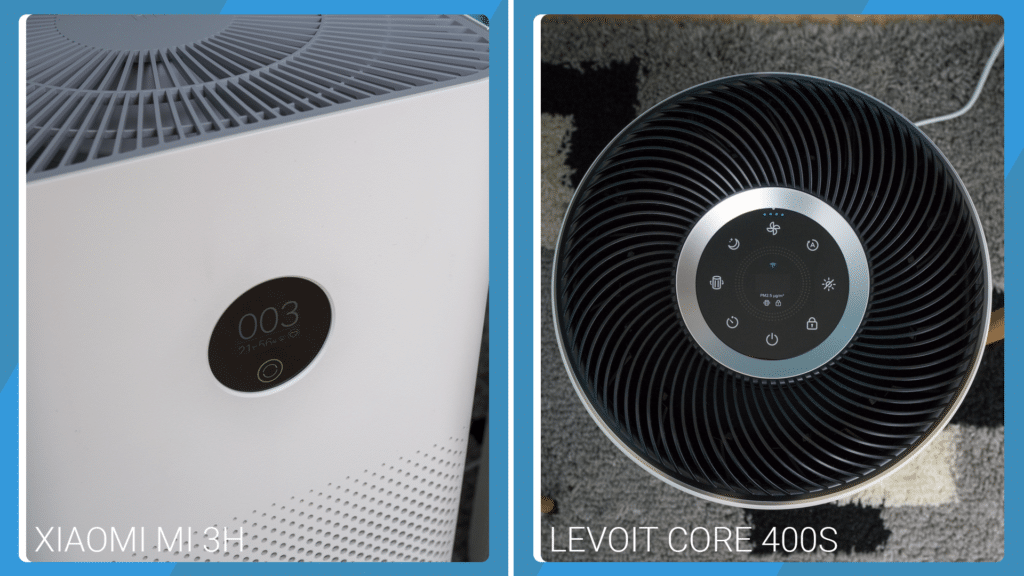
Firstly, I want to emphasize the features of these two air purifiers, including the air quality sensor, auto mode, smart app, and air quality indicator. All of these features undoubtedly raise the functionality of these two air purifiers to a much higher level. Below, I will explain the most essential features of these two air purifiers.
Air Quality Sensor and Indicator
The air quality sensor is a feature that adorns both devices. It’s a laser dust particle sensor that detects PM2.5 particles in real-time. The Levoit Core 400S uses AirSight Plus sensor, which can be found on most new air purifiers from Levoit.
Both Xiaomi and Levoit have a sensor located on the back of the device. It has a built-in stand-alone motor, which means the sensor will work even when the air purifier is off. This further means that you can monitor the air quality in the room at any time, provided that you have connected the air purifier to a smart app.
Although I would like the sensors in these air purifiers to be a little more accurate, I would still give a slight advantage to the Levoit sensor because Levoit allows you to adjust the sensor’s sensitivity. Of course, you have to connect the air purifier to the smart app to change the sensors’ sensitivity.
This sensor works in combination with other options on both devices, such as the air quality indicator and auto mode. On Levoit, the air quality indicator is located on the control panel, while on Xiaomi, this indicator is located around the control button.
In addition, both devices show the current amount of PM2.5 particles in the air on display. Additionally, if you connect devices with a smart app, you will be able to monitor the air quality in your room at any time and check what the air was like on some previous days.
Auto Mode
Auto mode is one of my favorite options that luckily adorn both these air purifiers.
Namely, when the air purifier is switched to auto mode, it will change the fan speed depending on the current air quality. So, it works in combination with the air quality sensor.
It is commendable that both devices have this option, but I would like to emphasize that Levoit’s auto mode is a little more advanced, and it is possible to adjust its sensitivity.
Humidity and Temperature Meter
The Xiaomi Mi 3H also has features that set it apart from the Levoit Core 400S. Those are the humidity and temperature meters, which essentially measure the current humidity and temperature in the room.
Xiaomi displays this information on the display as well as in the smart app. These are very useful values for people looking for a more comprehensive image of the air quality in the room.
VeSync and Mi Home Apps
I must note that Xiaomi Mi 3H and Levoit Core 400S use the state-of-the-art smart application available for Android and iOS devices.
The Levoit Core 400S can be connected to the VeSync app, which unlocks many new features and makes the device even easier to use.
Xiaomi Mi 3H uses the Mi Home app to control all Xiaomi devices. This app opens additional options on this device as well.
Of the options that I like and are available on both applications, I would single out the possibility of programming how the air purifier works. For example, you can set the air purifier to turn on if the amount of PM2.5 particles in the air exceeds a specific value.
Filter Reset Indicator
The Levoit Core 400S and Xiaomi Mi 3H use a filter reset indicator that will notify you when it is time to replace the filter. It is possible to check the current filter wear via the smart application on both devices.
Levoit, in addition, has a filter reset indicator located on the control panel that lights red when it is time to replace the filter.
Xiaomi, on the other hand, shows the current filter wear on display each time you turn on the device.
Airflow
The Levoit Core 400S draws air in at the bottom through openings on all sides. The air is then filtered and exits on the top. The Xiaomi draws air in the same way but only through the three sides, while the back lid doesn’t have holes. The filtered air exits on the top, the same as with the Levoit.
Warranty
When speaking of warranty, I want to say that Levoit gives a 2-year warranty for the Core 400S model, while the Xiaomi gives only 1 year for their Mi 3H model.
It would be much better if these devices provided a longer warranty, as is the case with some other brands that give even a lifetime warranty.
Xiaomi Mi 3H Vs Levoit Core 400S Video Comparison
Filtration Technology
Xiaomi Mi 3H and Levoit Core 400S use a 3-stage filter containing a pre-filter, True HEPA filter, and activated carbon filter. The filters in these two air purifiers are cylindrical, hollow through the middle, and located at the bottom of the device.
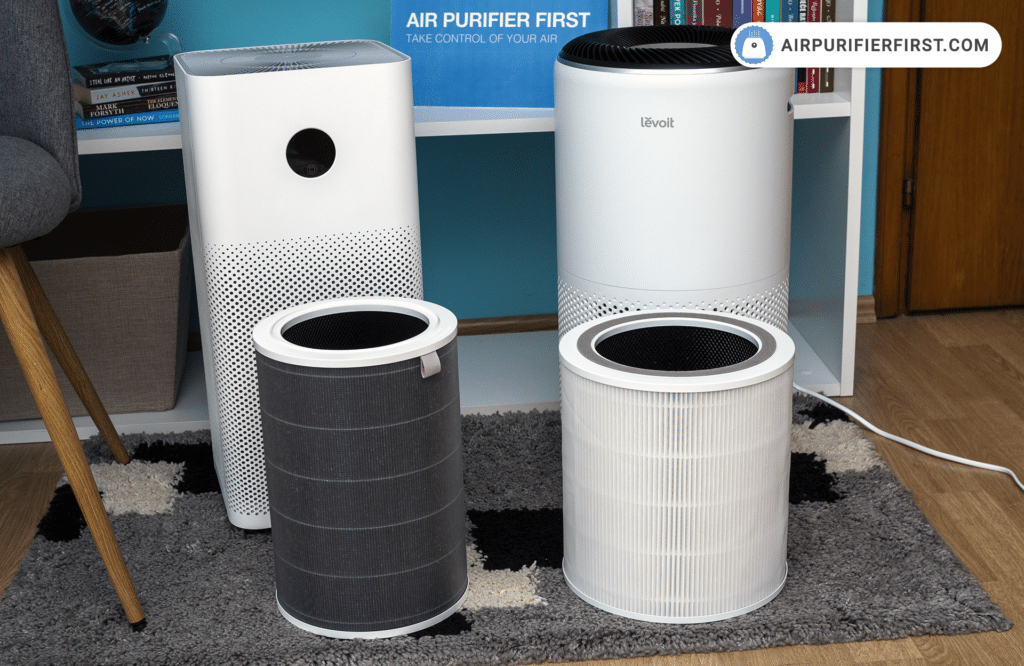
When it comes to the filter’s dimensions, there is not much difference, nor is there a big difference in the quality of the filter. Both devices use high-quality filters, which is confirmed in performance tests.
The first stage of filtration in both air purifiers is pre-filter, the second stage is True HEPA filter, and the last stage is activated carbon filter.
I really like that both devices use a pellet-based carbon filter, which is generally known as the market’s most efficient carbon filter type. Therefore, the performance of these devices in gas neutralization is also good.
I would also like to emphasize that these two air purifiers are 100% ozone-free and entirely safe to use.
How to Replace Filters on These Two?
The filters on these air purifiers are not washable. They are replaceable, which means that they need to be changed from time to time.
Fortunately, both air purifiers use a filter reset indicator that will notify you when it is time to replace the filter. On average, Levoit Core 400S filters last up to 12 months, while Xiaomi Mi 3H filters last between 6 and 12 months (approximately 150 hours).
Please remember that Xiaomi filters have a built-in RFID chip, so buying third-party replacement filters is not an option.
The process of replacing filters on these two air purifiers is straightforward. It does not require any advanced steps. I have explained the procedure in detail in individual reviews. The links are below.
Noise Tests
When it comes to the noise that these devices produce, firstly, I would like to commend the fact that both devices are equipped with 5 fan speeds. The more fan speeds the device has, the easier it is for the user to adjust and choose the speed that suits him best.
Additionally, I must say that these two devices also have a sleep mode option. In sleep mode, the Xiaomi Mi 3H produces a sound of only 40.9 dBA, while the Levoit Core 400S produces 42.1 dBA. This means you can easily use these two air purifiers in the bedroom, and trust me, you won’t even notice they’re there.
However, I have a minor complaint about the max speed, where both devices are a little too loud. Namely, Levoit produces a sound of 59.9 dBA at max speed, and Xiaomi produces a sound of 65.4 dBA. Although they are too loud at max speed, you should remember that they are also the most efficient at that speed.
All in all, these are very quiet devices, and I believe everyone will find the fan speeds that suit them best.
| Product | Noise Range (dBA) |
|---|---|
| Xiaomi Mi 3H | 40.9 – 65.4 dBA |
| Levoit Core 400S | 42.1 – 59.9 dBA |
Performance Tests
Levoit and Xiaomi are two large air purifiers designed for rooms of almost identical sizes. Levoit Core 400S covers rooms up to 403 sq. ft., while the Xiaomi Mi 3H covers slightly larger rooms, 484 sq. ft. in size.
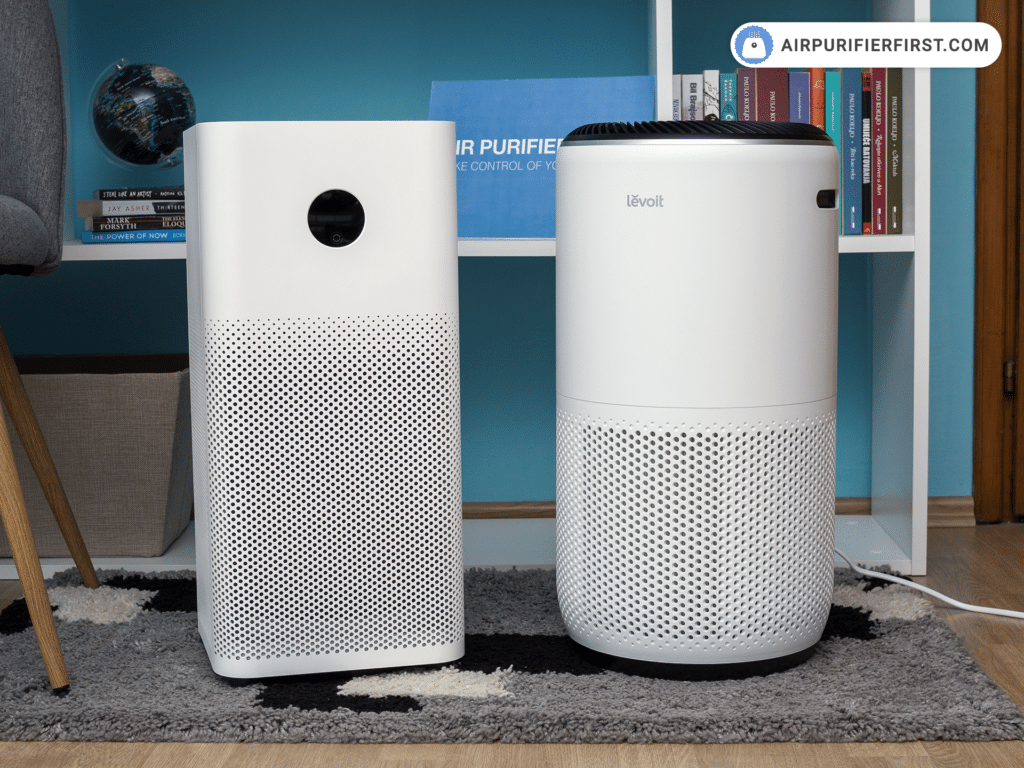
In addition, these two air purifiers use high-quality filters, which are also very similar in dimensions. All this made the testing process much easier for me because of which I tested them in the same room sizes.
320 sq. ft. Room Test
In the first test, in a room of 320 sq. ft. Levoit Core 400S improved the air quality by about 96% in 60 minutes, working at the max speed, while the Xiaomi Mi 3H improved the air quality by about 95% in the same conditions.
320 sq. ft. Room
* Data measuring time is 60 minutes.
This is an outstanding result, which somehow I expected from these two air purifiers. Even though Levoit had a slightly better result in this test, I can easily consider this test a draw.
560 sq. ft. Room Test
In the second test, this time in a room of 560 sq. ft., which is a bit larger than the recommended dimensions, these air purifiers made terrific performance. Xiaomi Mi 3H improved the air quality by about 90%, working at max speed for 60 minutes, while Levoit Core 400S improved the air quality by about 91%.
560 sq. ft. Room
* Data measuring time is 60 minutes.
This is proof of the high-quality filters these air purifiers use.
Operating Costs
It doesn’t happen very often, but these two air purifiers use a motor of the same power, just 38W. While using 35W at the max speed for Levoit and the 39W for the Xiaomi, these are not large power consumers.
This means that if we left these devices running at max speed, 24 hours per day, for one month, the Xiaomi Mi 3H would increase your electricity bill by about $3.4, while the Levoit Core 400S would increase your electricity bill in the same circumstances for about $3. Do you agree that this is not a very big expense? Especially if we consider the benefits, you get from using these devices.
| Product | Wattage Range (W) |
|---|---|
| Xiaomi Mi 3H | 0.9 – 39W |
| Levoit Core 400S | 0.9 – 35W |
In addition to electricity costs, there are also the costs of replacement filters. Luckily filters on these air purifiers are very durable and last about 12 months, on average. However, replacement filters for the Levoit Core 400S are a bit cheaper.
Furthermore, if we summarize the electricity consumption and the price of replacement filters, the Levoit Core 400S is more affordable for maintenance than the Xiaomi Mi 3H on an annual basis.
Which One Does It Better?
Regardless of all the similar features and great performances, I must say that choosing a winner wasn’t easy at all.
However, the point of all the comparisons I make is to choose the winner and, in that way, make it easier for potential buyers to select the one. In my opinion, the Levoit Core 400S is a better buying option. A slightly better performance, lower maintenance costs, more affordable replacement filters, and a better smart app are reasons for Levoit winning the battle.
If you decide to go for Xiaomi, you won’t go wrong because it is also a high-quality and reliable air purifier. If you have any questions or suggestions, please feel free to comment in the comments box below.
Leave a Reply